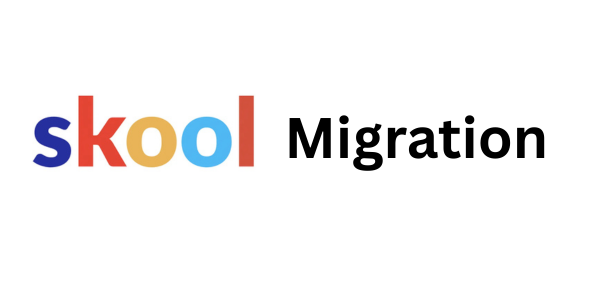Skool has made a big splash in the creator world over the past few years. Its clean, distraction-free design and simple combo of courses + community have helped thousands of creators run memberships, masterminds, and coaching programs smoothly.
But as your business grows, you might start feeling Skool’s limitations. Maybe you want more control over your branding. Maybe you need advanced course features, different pricing structures, or more robust integrations.
If you’re ready to move on, this step-by-step guide will help you migrate from Skool to a new platform smoothly, strategically, and without losing your members or content.
.png)
Why Creators Are Leaving Skool in 2025
Skool is still a fantastic platform for many creators, but it’s not a perfect fit for everyone. The most common reasons people are making the switch include:
- Limited customization: Skool has a clean interface, but you can’t change layouts, fonts, or overall design much.
- Few pricing options: One flat monthly price for all members works for some, but not for creators with tiered membership models.
- Basic course features: While great for straightforward lessons, it lacks more advanced LMS tools like certificates, compliance tracking, or detailed analytics.
- Integration gaps: If you want deep automation with your marketing stack, you might need workarounds or third-party tools.
Top Alternatives to Skool in 2025
If you’re thinking of moving, here are some top alternatives you can consider:
1. SchoolMaker
Best for: Driving more course and coaching sales
- Focus on driving better learner outcomes
- White-labeled branding
- Progress tracking, certificates, and advanced course organization
- Community and drip content features
- Analytics to monitor engagement
Starts at $29/month
2. Circle.so
Best for: Highly customizable community + course platform
- Flexible spaces for discussions, courses, events, and live calls
- Custom domains and full branding options
- Built-in payments via Stripe
- Better suited for complex membership structures
Starts at $89/month
3. Kajabi
Best for: All-in-one business operations
- Website builder, email marketing, funnels, courses, community
- Marketing automation and upsells
- Great for creators who want everything in one tool
Starts at $89/month
.png)
4. Podia
Best for: Simple all-in-one platform at a lower cost
- Sell courses, memberships, coaching, and digital products
- Built-in community feature
- No transaction fees on paid plans
Starts at $39/month
5. ThriveCart Learn
Best for: One-time purchase course hosting
- Lifetime access after a single payment
- Checkout optimization and upsells
- Easy drag-and-drop course builder
One-time fee
Step-by-Step Skool Migration Plan
Once you’ve chosen your new platform, here’s how to move your content, members, and community without confusion.
Step 1: Audit Your Skool Setup
Make a list of what you currently have in Skool:
- Courses (number of lessons, formats)
- Community spaces and discussion threads
- Events and calendar items
- Member data (names, emails, join dates)
- Any integrations or automations you’ve set up
This list becomes your migration checklist.
Step 2: Export Your Content
Skool doesn’t have a one-click export for everything, so you’ll need to manually gather:
- Videos: Download from your hosting provider (Vimeo, Loom, YouTube, etc.)
- Lesson text: Copy to Google Docs or Notion for easy reuse
- Attachments: Save all PDFs, templates, and resources to a local folder
- Member list: Export or copy into a CSV (Skool lets you view member emails for this)
Tip: Start with your most important course so you can relaunch quickly.
Step 3: Build Your New Platform
Once your assets are ready, set up your new space:
- Upload your course content
- Recreate lesson flow and module structure
- Set up your community spaces or groups
- Rebuild event calendars (if moving to a platform with events)
- Add your branding, colors, logo, fonts
- Connect payment gateways (Stripe, PayPal, etc.)
Step 4: Migrate Your Members
Here are your main options:
- Bulk import via CSV (if supported by your new platform)
- Invite manually via email with join links
- Offer a limited-time bonus, free month, or discount for early movers
- Use a simple step-by-step guide for members to set up their new accounts
Step 5: Redirect Links and Update Access Points
To keep things smooth:
- Update links in your website, social media, and emails
- Replace event links or community invites in existing materials
- Send new affiliate links to your affiliates (If you have an affiliate program)
Step 6: Communicate Clearly With Your Audience
This part makes or breaks your migration. Send a series of updates explaining:
- Why you’re making the change
- How it benefits members
- What steps they need to take
- When the change will happen
Consider hosting a live Q&A or “welcome tour” on your new platform to help members get comfortable.
Step 7: Run Both Platforms Temporarily
Keep Skool active for 2–4 weeks after launch. This gives you:
- Time to handle technical issues
- A safety net for members who are slow to switch
- Space to double-check that payments and logins work
Once you’re confident, cancel your Skool plan.
Bonus Tips for a Smooth Skool Migration
- Test your new setup as if you’re a member; check logins, lesson access, and payment flows.
- Archive key community discussions so they’re not lost forever.
- Start with your flagship offer, get it right, then move the rest.
- Use migration as a rebrand opportunity to refresh your content and offers.
.png)
Conclusion
Migrating from Skool in 2025 isn’t just a tech thing, it is a chance to create a better experience for your members.
Whether you’re moving for more customization, advanced learning tools, or stronger marketing features, the key is to plan carefully, migrate in phases, and communicate every step of the way.
The platform is just the container. Your community, your teaching, and your content are what really matter, and those will move with you.













